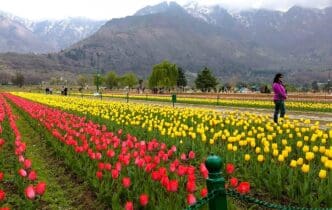Warmer-than-usual spring temperatures and a significant lack of snowfall are challenging the Indira Gandhi Memorial Tulip Garden in Srinagar, Jammu and Kashmir, as it endeavors to preserve its vibrant display of 1.7 million tulips.
These weather anomalies, attributed by experts to climate change and global warming, have led to an 80% deficit in rain and snow in the region this year, adversely affecting the growth of the tulips. With average temperatures rising 5 to 8 degrees Celsius above normal, many of the garden’s tulips are now showing signs of wilting.

The garden, a popular attraction drawing thousands of visitors annually, depends on imported tulip bulbs and careful breeding to achieve its colorful display. However, the current drought-like conditions have posed significant challenges to maintaining the garden’s usual splendor.
The Impact on Daily Life
The garden’s struggles highlight the broader implications of climate change, serving as a reminder of the need for global efforts to mitigate its effects on natural and cultural landmarks.
The tourism industry in the region may experience a downturn as fewer visitors are attracted to the garden, impacting local businesses that rely on tourist spending.

Farmers and horticulturists in the area could face increased difficulty in cultivating crops and plants, affecting their livelihoods and local food supplies.
Residents may experience a broader impact on water resources, as the lack of snowfall and rainfall could lead to shortages in the coming months.

The rising temperatures and changing climate conditions may prompt increased discussions and initiatives around environmental sustainability and climate adaptation in the community.








